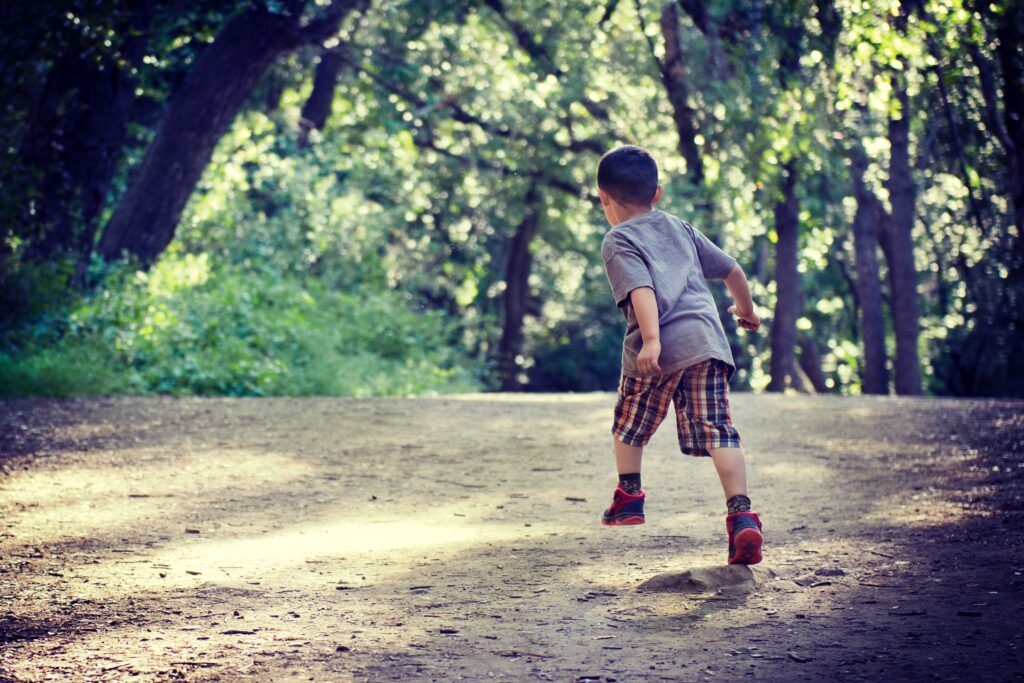If your autistic child is always running, this is the article for you. We explain what may be behind the behaviour and what you can do.
Autism and running
As parents of autistic children most of us are exposed to some quite quirky behaviours.
One common behaviour observed in some autistic children is a strong desire to run or engage in constant movement.
This article aims to shed light on the reasons behind this fascination with running and explore how it can be understood and supported.

Sensory processing
Autistic kids often have unique sensory processing patterns.
Running or constant movement can serve as a sensory stimulant that helps them regulate their sensory input.
The repetitive motion provides a predictable and rhythmic experience, allowing them to self-soothe or seek sensory feedback they may be lacking in their environment.
Running can help autistic children cope with overwhelming sensory experiences by providing a familiar and controllable activity.
Proprioceptive and Vestibular Stimulation
Running offers substantial proprioceptive and vestibular input, which can be particularly appealing to autistic children.
The proprioceptive system provides information about body position and movement, while the vestibular system relates to balance and spatial orientation.
Autistic individuals may have slightly different processing in these areas, and running helps them engage and regulate these systems.
The physical activity and feedback from running can contribute to improved body awareness and a sense of control.
Emotional regulation
Autistic children often face challenges related to emotional regulation and anxiety.
Running can be an effective outlet for pent-up energy and emotions.
It offers a constructive way to release stress and anxiety, providing a physical and emotional release.
The repetitive motion of running can serve as a calming mechanism, allowing them to find comfort and a sense of order in their surroundings.
Focus
Despite what may be the common thought path, running and constant movement can actually enhance focus and attention.
If you think about it, when you run as an adult (jogging for example) it is easy to focus your mind.
It is likely that your child is doing similar.
Physical activity can stimulate the brain, increase blood flow, and improve overall cognitive functioning.
Running may help autistic children better engage with their environment and maintain attention during other activities.
It can serve as a precursor to focused tasks, enabling them to transition into quieter or more structured activities with increased readiness.
What parents can do about autistic running
Understanding and supporting an autistic child’s fascination with running is essential for their well-being.
Here are some things to consider;
Safety
You can park this in the obvious column but it is something easily forgotten.
Parents should consider creating or designating safe areas where their child can engage in running freely.
This may mean clearing clutter or removing obstacles such as leads and other trip hazards.
Make it a joint endeavour
If you feel your child’s running is having a negative impact on their social development you can try and get involved.
One tactic would be to run together with your child and then suddenly stop and shout “freeze” to turn it into a game.
Alternatively you could countdown to the next burst of running.
Cater to your child’s needs
You could allow for regular running or exercise breaks during academic or structured activities.
These breaks can involve short bursts of running or movement to help the child regulate their sensory input and recharge.
Provide structure
You could introduce structured physical activities like sports, dance, or martial arts that provide a similar sensory experience.
These could give your child what they desire while also fostering social interaction and skill development.
Consider therapy
You could consult with occupational therapists, psychologists, or other healthcare professionals who specialise in autism .
They can provide personalised strategies and interventions to address the child’s running and help them to thrive.
Summary – Autistic child always running
The fascination with running in autistic children can be seen as a manifestation of their unique sensory processing needs.
Understanding the reasons behind this behavior can help parents provide appropriate support and accommodations.
By creating an environment that embraces their sensory preferences parents can help autistic children thrive.
All the while respecting their need for movement and self-expression.

